Construction Punch Lists
-
Sapna
- May 24, 2024

A construction punch list is a critical tool used in the final stages of a construction project to identify and address any remaining tasks or issues before the project is considered complete. These lists are often created during a walkthrough with key stakeholders like contractors, architects, and owners, ensuring that all work meets the agreed-upon standards and details.
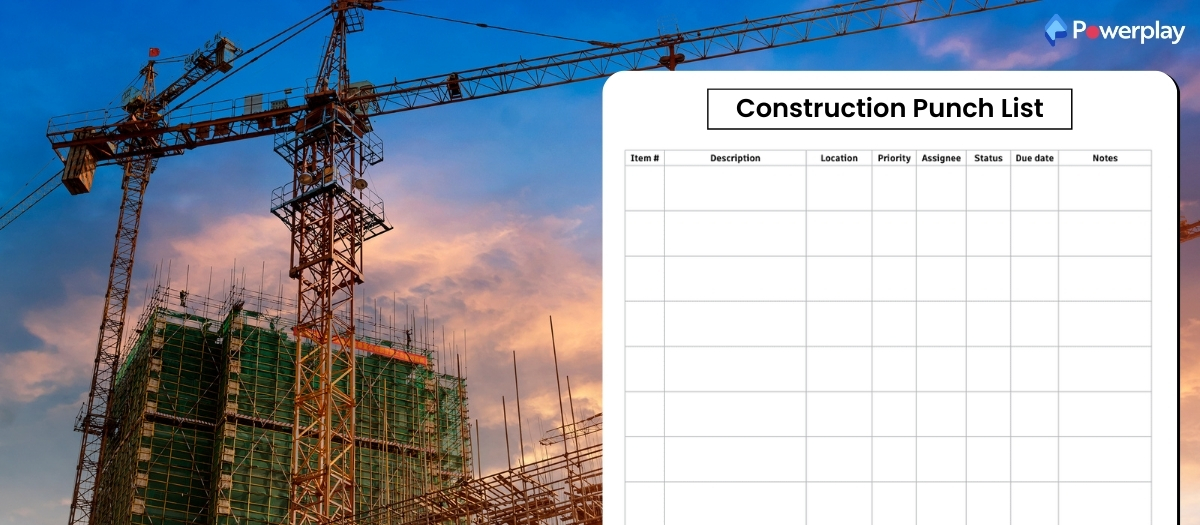
However, managing punch lists can be challenging due to the complications of construction projects and the need for precise coordination among various parties. Common issues include communication gaps, delays in addressing deficiencies, and difficulties in tracking the completion of listed items. This blog provides valuable insights into effectively using punch lists in construction projects. By exploring best practices, innovative tools, and real-world examples, readers can learn how to streamline their punch list process, enhance project efficiency, and ensure a smoother transition to project completion.
Table of Contents
What Is a Construction Punch List?
A construction punch list is a document used in the ending stages of a construction project. It outlines work that has yet to be completed, or that needs correction before the project can be considered complete and payment made.
This list may be created by the project owner, architect, designer, or general contractor as they inspect the project. Common issues on punch lists include minor damages like scratches, incorrect installations, and sometimes even new items not initially specified in the project. The general contractor typically assigns these items to subcontractors for resolution. The goal is to resolve all items on the punch list for project closeout.
When Are Construction Punch Lists Typically Executed?
Construction punch lists are typically executed towards the end of a construction project when most of the work has been completed. This stage is known as “substantial completion,” where only minor adjustments, fixes, and corrections remain. The punch list is generated during a walkthrough conducted by the project owner or client, the general contractor, and other relevant parties like architects and designers. This process ensures that all work meets the required standards and specifications before the final payment is made.
Who’s Responsible for Construction Punch List Items?
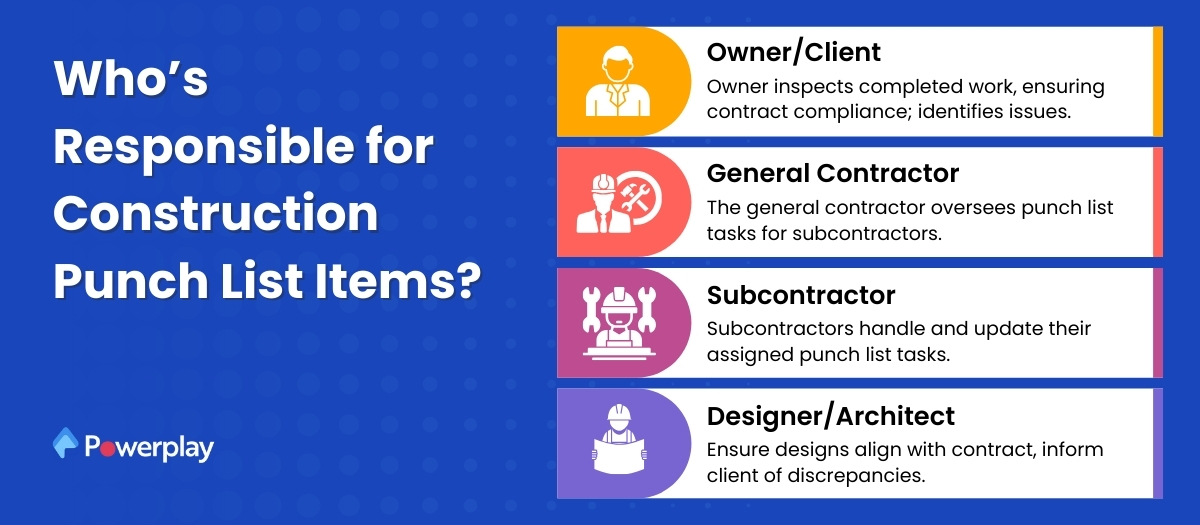
In a construction project, the responsibility for punch list items is shared among various stakeholders, each playing a distinct role:
Owner/Client: The project owner inspects the completed work to ensure it matches what was agreed upon in the contract. They identify any issues that need correction.
General Contractor: The general contractor oversees the punch list process, including examining details and assigning specific tasks to subcontractors based on their areas of expertise.
Subcontractor: Subcontractors are responsible for addressing the specific items assigned to them on the punch list. They provide updates and address concerns related to their assigned tasks.
Designer/Architect: They ensure the designs are implemented correctly and align with the original contract. They also inform the client and contractor if any discrepancies are found.
What information does a construction punch list provide?
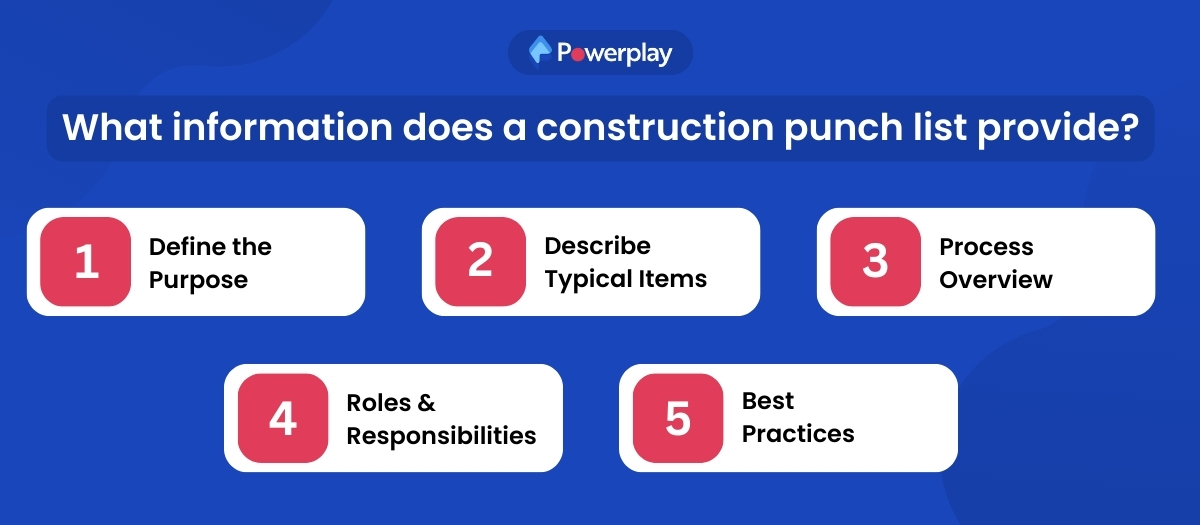
A construction punch list documents and rectifies any remaining tasks or issues at the end of a construction project before considering the project complete. This list typically includes items that need testing, additions, repairs, or removal to ensure the project meets the agreed-upon standards and specifications.
While crafting a construction punch list, ensure it includes the following:
Define the Purpose: Explain that a punch list documents any outstanding work that must be addressed before final payment is made and the project is handed over to the client. It ensures that all contractual obligations are fulfilled.
Describe Typical Items: Include examples of what might appear on a punch list, such as testing doors, windows, and appliances, adding hardware or final coats of paint, repairing drywall damage or flooring issues, and removing construction debris and tools.
Process Overview: The creation and execution process of a punch list typically involves the project manager conducting a pre-inspection, then a walkthrough with the project owner, followed by the correction of any deficiencies before releasing the final payment.
Roles and Responsibilities: While the general contractor typically owns the punch list, its execution involves various stakeholders, including subcontractors, architects, and the project owner, each playing a role in completing the tasks.
Best Practices: Suggest best practices like treating the punch list as a living document that evolves with the project, clear task delegation, constant inspections, realistic budgeting, and thorough documentation using photos and checklists.
Why use a construction punch list?
A construction punch list is essential for ensuring the quality and completeness of a construction project before the final handover. It allows stakeholders to identify and rectify any remaining defects or unfinished work, ensuring that the project meets the agreed-upon standards and specifications.
This process prevents costly post-completion repairs and enhances client satisfaction by delivering a finished product that meets contractual obligations. The punch list also facilitates clear communication and accountability among all parties involved, from general contractors to subcontractors, ultimately improving project efficiency and reducing the risk of disputes.
Punch list template
This punch list template streamlines the final inspection and correction process for projects, helping the team track and manage necessary repairs to complete all tasks on time and to the required standards.
Punch List Stats
Punch lists in construction ensure that all tasks, especially those remaining towards the end of a project, are completed to meet contractual agreements. Traditionally, punch lists were completion is primarily at the project’s end, but recent trends show a shift towards a more dynamic approach known as “punchlist-as-you-go.” This method involves continuously updating the punch list throughout the construction process as each work segment is finishes. This approach leads to more efficient project closeouts, reduced delays, and better overall quality management.
A study by Autodesk and Dodge Data & Analytics highlighted that many contractors now use software to manage punch lists and closeout activities, streamlining the process and reducing the frequency of unresolved issues. This shift not only improves the quality of construction projects but also helps in managing timelines and budgets more effectively.
Improving Construction Punch Lists Once and For All
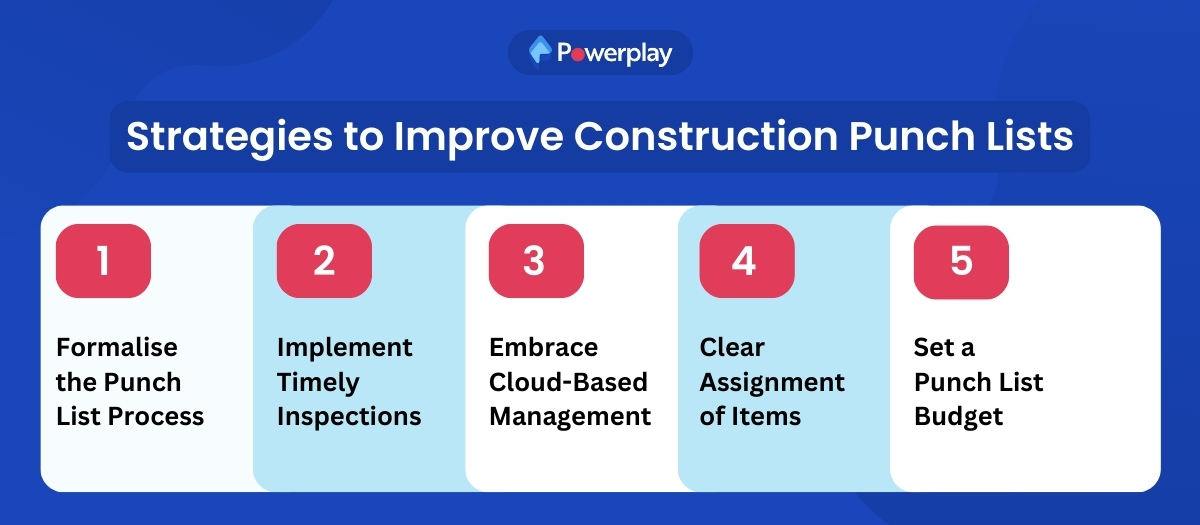
To improve construction punch lists effectively, consider the following strategies:
Formalise the Punch List Process: Transition from informal punch lists to a structured approach integrated with your regular inspection processes. Use detailed checklists during inspections to identify issues and include photos or marked-up images to illustrate problems clearly. This ensures nothing is misses and enhances job quality.
Implement Timely Inspections: Schedule regular inspections or “punch walks” to quickly identify and address critical items. Let subcontractors manage their quality control for non-critical issues, streamlining the overall process.
Embrace Cloud-Based Management: For punch list management, move away from paper-based systems and use cloud technology. This allows for real-time communication and tracking of issues from the field, significantly reducing inefficiencies and risks.
Clear Assignment of Items: Assign specific responsibilities for each punch list item to individuals or teams. Use software tools to assign, alert, and track accountability, ensuring everyone is clear on their tasks and responsibilities.
Set a Punch List Budget: Establish a budget for punch list items as part of the initial project allocation. This helps keep the project within budget and accelerates the completion of punch list tasks.
Best practices for using a punch list
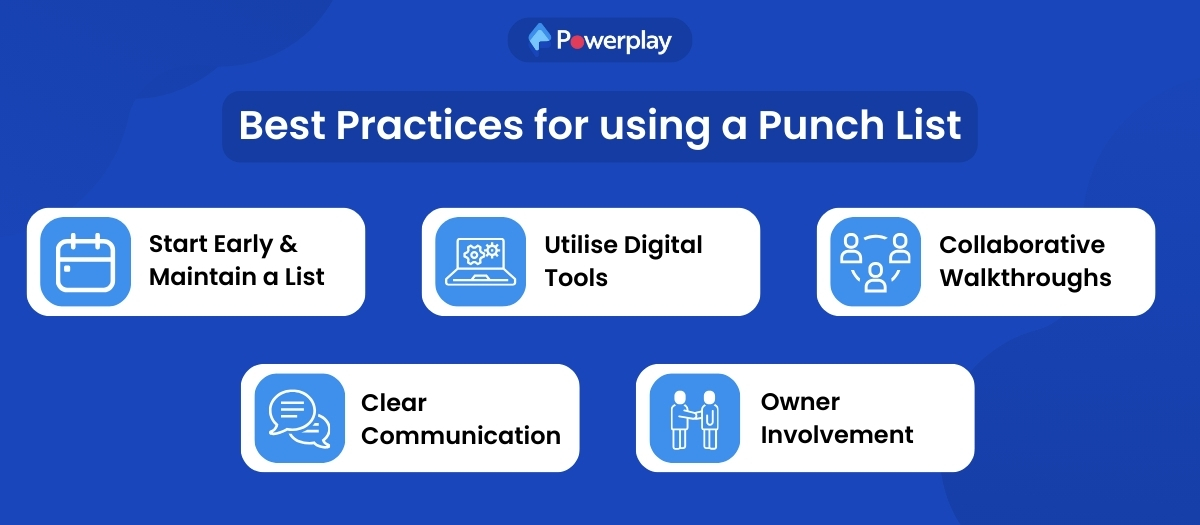
To effectively manage punch lists in construction projects, here are five best practices:
Start Early and Maintain a Rolling List: Don’t wait until the end of the project to begin the punch list. Start as soon as the project begins, documenting any issues immediately. This approach, known as a “rolling punch list,” helps identify and resolve issues in real-time, reducing the workload at project completion and striving towards a zero-punch list goal.
Utilise Digital Tools: Embrace construction management software to manage punch list items efficiently. This technology allows you to document issues, attach photos, and communicate with team members directly from the field, enhancing transparency and accountability among all stakeholders.
Collaborative Walkthroughs: Engage all key stakeholders, including owners, architects, and subcontractors, in regular site walkthroughs. This collaborative approach ensures that everyone aligns, identifies issues, and assigns them to the responsible parties for resolution.
Clear Communication and Documentation: Ensure every punch list item is clearly communicated and documented, including the specific details of the deficiency, location, and required actions. Use apps and software that support real-time updates and communication to keep all parties informed.
Owner and Architect Involvement: Encourage the project owner to participate actively in the punch list process, asking critical questions that may lead to additional items. Similarly, architects should verify that all resolved items match the final project drawings, ensuring that the final product meets the original specifications.
Examples of Punch List Items
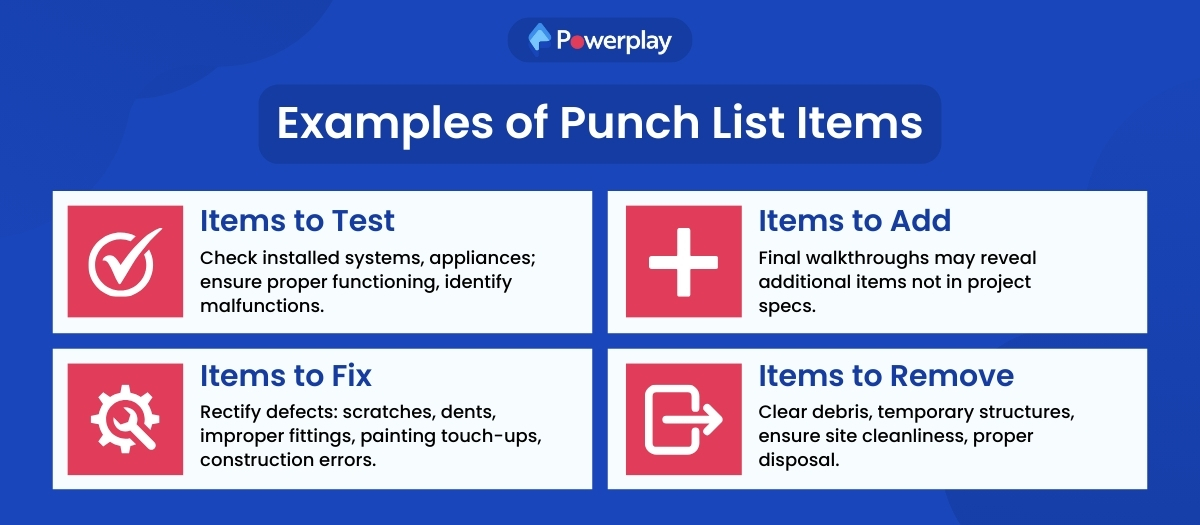
Here’s an overview of what typically goes into each category of a construction punch list:
Items to Test
This includes checking all installed systems and appliances to ensure they are functioning correctly, such as testing the electrical systems, HVAC units, plumbing, and any other mechanical systems. It’s crucial to identify any malfunctioning components that need repair or adjustment.
Items to Add
During the final walkthroughs, sometimes stakeholders identify additional items that weren’t part of the initial project specifications. This could include extra fixtures, finishes, or installations that the owner decides are necessary for the project’s completion.
Items to Fix
These are defects or incomplete tasks that need to be rectified. Common issues include minor damages like scratches or dents on surfaces, improperly fitted doors or windows, painting touch-ups, and correcting construction errors that deviate from the project specifications.
Items to Remove
This category involves clearing out any unnecessary materials, debris, or temporary structures left over from the construction process. It ensures the site is clean and all non-essential items are dispose properly.
Responsibility for Punch List Items
In construction projects, general contractors primarily handle responsibility for punch list items and rely on their subcontractors to complete the necessary trade work. This involves:
General Contractor’s Role: The general contractor is ultimately responsible for ensuring that all items on the punch list are completed. They coordinate with various subcontractors to schedule and complete each item promptly.
Subcontractors’ Responsibilities: Based on the type of work required, specific contractors or subcontractors are assigned punch list items. They use a punch list to complete their contractual work and receive payment after getting a certificate of substantial completion.
Coordination and Communication: The general contractor must clearly delegate tasks and deadlines to avoid uncertainty about who is responsible for each item. Technology and software can help clarify these assignments and remind subcontractors of outstanding work, leading to more efficient completion.
Final Walk-Through and Acceptance: Once the punch list items have been completed, a final walk-through is conducted with the project owner, general contractor, and architect or engineer to ensure all items have been corrected. The project owner then signs off on the list as complete. Also makes the official completion of the project and triggering the final payment.
How Powerplay can help in the construction punch list for owners, contractors and subcontractors?
Powerplay can significantly enhance the construction punch list process for owners, contractors, and subcontractors by centralising and streamlining communication and task management. This software lets all parties access real-time updates on punch list items, ensuring they stay informed about each task’s status.
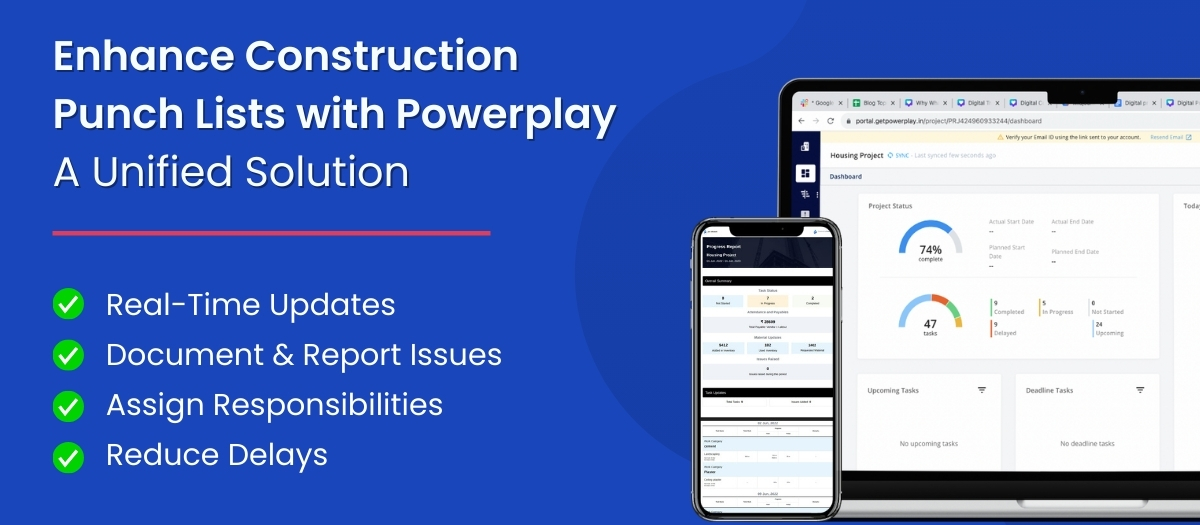
Contractors and subcontractors can quickly document and report issues, attach photos, and assign responsibilities. For owners and project manager, Powerplay offers transparency and visibility into the project’s progress, enabling more effective oversight. It also ensures that stakeholders meet all contractual standards before project closeout. This collaborative approach reduces delays and improves overall project efficiency.
Conclusion
Punch lists are a vital of ensuring that a construction completion of project is according to agreed-upon standards and specifications. This list serves as a final check to identify and rectify any remaining defects or issues before the project’s handover. Using a punch list, stakeholders ensure that they review all aspects of the project and make all necessary corrections. This leads to improved client satisfaction and reduced likelihood of post-completion disputes.
Powerplay is one of the best construction management software that helps you enhance this process by providing real-time updates and facilitating communication among all involved parties. Efficiently and effectively ensuring the completion of project. This collaborative approach helps maintain high-quality standards and ensures a smooth transition to project completion.













